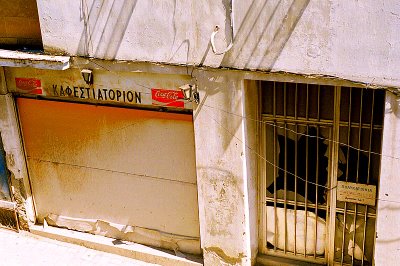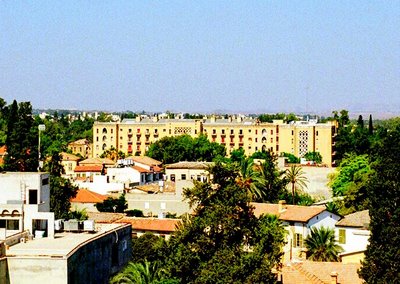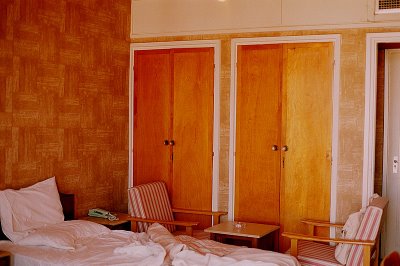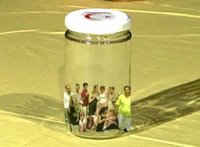Photo Essay: A Tale of Two Hotels
- MY HOTEL KICKED ME OUT. Oh, not because I was rowdy or neglected to pay my bill. They’d booked a large conference the last week of August, and somehow forgotten to mention this during the many weeks when I was rattling around their nearly empty hallways last summer. Nicosia is not on most tourist itenararies; and this was a so-so business class hotel. Not much business gets done in Nicosia in August, with temperatures reaching 42 degrees celcius, or about 110 fahrenheit. But I stayed at the Classic Hotel, on the Greek side of Nicosia, because it was just a few minutes walk to the Turkish side of town. Even on the Greek side, the area near the crossing point hasn’t been rehabilitated. The photo above was the view from the balcony of my room at the Classic Hotel.
- The barricades above were literally a stone’s throw from the front door of the Classic Hotel. Look closely, and you’ll see the Greek and Greek Cypriot flags flying behind the broadcast tower. The Turkish and Turkish Cypriot flags are flying in a park across the street—and across the Green Line—just one of many angry flag faceoffs in Nicosia, where barely a few yards separate the two sides at some points. The buildings below are directly across the street from this spot. The old United Nations lookout post has been abandoned for another post further on. The Roman Catholic church is, paradoxically, within the Green line. But it is still accessible from the Greek side, and well attended on Sundays—particularly by the community of Sri Lankan guest workers who live in the neighborhood.

- When the Classic kicked me out, I humped my backback and laptop across the all-too-visible dividing line to the Saray Hotel, on the Turkish side of Nicosia. I had been meeting Turkish Cypriot sources for coffee at the tables in the plaza in front of the Saray all that summer, so it seemed like the obvious choice. But the Saray (pronounced “suh-rye”) was also one of only two hotels on the Turkish side of Nicosia that wasn’t a flea-bitten doss house for Turkish soldiers, or worse. I should point out that the Saray didn’t always hang those giant Turkish and Turkish Cypriot flags on the front of the building. But when I moved in, during the last week of August, north Cyprus marks a national holiday in Turkey.
- But oh, the views! What began as a chore—moving hotels when I was practically at the end of my stay in Cyprus—turned out to be a lucky break. I’ve already written about the view of a small mosque from my room at the Saray in “Nicosia Echoes.” But the rooftop of the Saray offered a panoramic survey of Nicosia’s history. The building above is Ledra Palace, a palatial British colonial era hotel that now houses United Nations peacekeepers. The pedestrian crossing point between the two sides of Nicosia is just a few yards beyond Ledra Palace Hotel.
- You have to peer beyond the habitual haze of August to see them, but Turkish Cypriots long ago laid out painted rocks in the hills overlooking Nicosia to form the Turkish and Turkish Cypriot flags. As you’ve no doubt noticed by now, the Turkish Cypriot flag—which is red-on-white—is practically the mirror image of the Turkish flag. These rock formations can be seen all across the Greek side of the city. Many Greek Cypriots say that if the new Turkish Cypriot leader, Mehmet Ali Talat, really wanted to work toward reunification then he would have removed these from the hillside after he took office.
If you were standing on the rooftop of the Saray Hotel now, looking at the flags in the hills, you would only have to turn your head slightly to the right to see Selimiye Camii, a vast mosque at the heart of the old walled city. Originally, this was a Roman Catholic cathedral called Ayia Sofia, the work of French masons who accompanied the crusaders. Construction began in 1209, but when the Ottoman Turks captured the city in 1570, they converted the cathedral to a mosque. At least in August, when I observed one of the prayer services, Selimiye Camii was sparsely attended. Perhaps a dozen men and boys answered the muezzin’s call to afternoon prayer.
- The word “Saray” is Turkish for “Paris.” But there was nothing plush or Parisian about the rooms. In fact, I don’t believe that an interior decorator had roamed the halls of the Saray since the early 1970s. The photo of my room above was taken from the tiny balcony. I went up to the restaurant on the night that I checked in and asked to see the dinner menu. The waitor replied in perfect English that they didn’t have a menu. They had chicken and salad. I asked him if they had anything for dessert. He hesitated a moment and then said, “We have powdered milk.’ I will end this photo essay on a personal note. The backback below is all the kit that I ever travel with, other than my laptop bag. Yes, it’s a limited amount of space. But if you make an effort, all of life’s necessities can be folded into a remarkably small amount of space.













